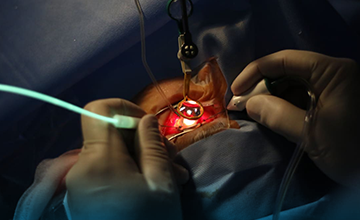- primevisionarkan@gmail.com
- Arkan Medical Building 7, Fifth floor Clinic C5-1
- 01080677020
Vitrectomy
- Home
- VITREO – RETINAL SURGERIES
- Services
- Vitrectomy
- All Services
- LASIK SURGERIES
- CORNEAL TRANSPLANT
- CATARACT SURGERIES
- GLAUCOMA SURGERIES
- VITREO - RETINAL SURGERIES
- --Vitrectomy
- --INTRA- VITREAL INJECTIONS
- PEDIATRIC SURGERY
- --Strabismus
- --Congenital Cataract
- --Congenital Glaucoma
- OCULOPLASTIC SURGERIES
- --Eyelid surgery
- --DCR
- --Orbital Surgeries
- EYE MEDICAL DISEASES
- CONTACT LENSES
What Is Vitrectomy?

Vitrectomy is a type of eye surgery used to treat problems of the eye’s retina and vitreous. In this surgery, an ophthalmologist may:
- Remove blood or other substances keeping light from focusing properly on the retina.
- Remove scar tissue that is wrinkling or tearing the retina and causing poor vision.
- Help repair a retina that has detached (pulled away) from the eye wall.
- Remove a foreign object stuck inside the eye from an injury.
During vitrectomy, the ophthalmologist removes some or all of the vitreous from the middle of your eye. This vitreous is replaced with either a salt water (saline) solution or a bubble made of gas or oil. During healing after surgery, your eye replaces the saline solution or the bubble with the natural fluid the eye makes, called aqueous humor.
When is vitrectomy done?
Your ophthalmologist may recommend a vitrectomy if you have one of these diseases or conditions:
- Diabetic retinopathy, with bleeding or scar tissue affecting the retina or vitreous gel.
- Some forms of retinal detachment (when the retina lifts away from the back of the eye).
- Macular hole (a hole or tear in the macula).
- Macular pucker (wrinkles or creases in the macula).
- An infection in the eye is called endophthalmitis.
- Severe eye injury.
- Certain problems during cataract surgery.
What happens during a vitrectomy?
Vitrectomy is usually done in an outpatient surgery center. You will have local or general anesthesia to numb the eye. Surgery can take from one to several hours.
During surgery, the ophthalmologist will make a small cut (incision) or use special blades to insert the instruments into the whites of the eye (sclera). They will use a microscope to see inside your eye. Your surgeon will use tiny tools to do one or more of these steps:
- Remove all cloudy vitreous.
- Remove scar tissue from the retina.
- Remove any object that should not be in the eye.
- Return the retina to its proper position against the back of the eye.
- Use a laser to repair a torn retina or other procedures.
- Place an air or gas bubble in your eye to help the retina remain in its proper position (the bubble goes away on its own).
- Place silicone oil in your eye (oil removed later during a second surgery).
Following the surgery, you will be monitored as you rest and recover from anesthesia. Then you can go home.
What happens after vitrectomy surgery?
Your ophthalmologist will prescribe medicine to help the eye heal appropriately and to relieve eye discomfort. Pain is very rare after vitrectomy, but a scratchy or sandy sensation—as if something is inside your eye—is common. This will disappear with the medicines and time.
Your doctor will have you wear a patch on your eye for a few days to protect it. They will tell you when you can safely return to your normal activities.
If a gas bubble was placed in your eye:
You may need to keep your head in a facedown (or side-facing) position for a specific period of time. Your ophthalmologist will tell you exactly how long to stay in that position. It is very important to follow these instructions to heal properly.
You cannot fly in an airplane, go to the mountains, or scuba dive until the gas bubble is gone. This is because a rapid altitude change can affect the size of the bubble.
